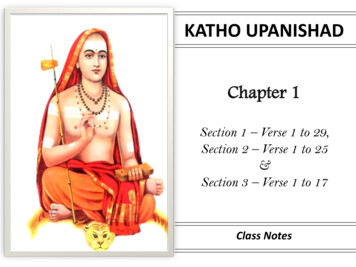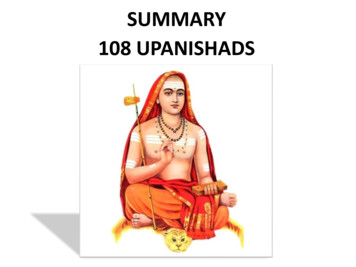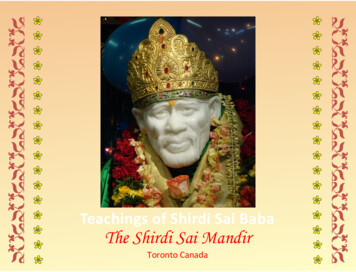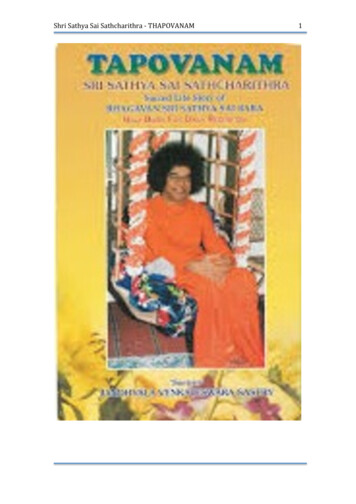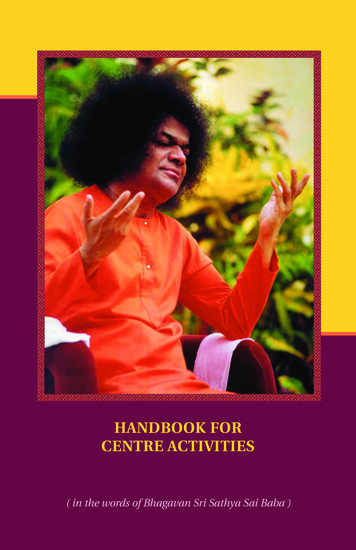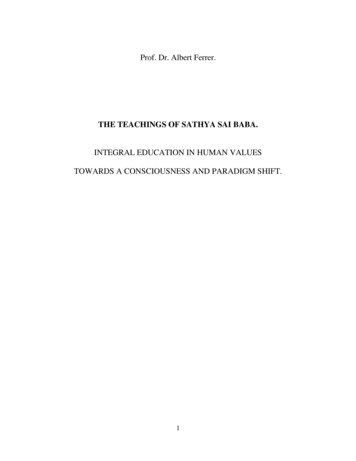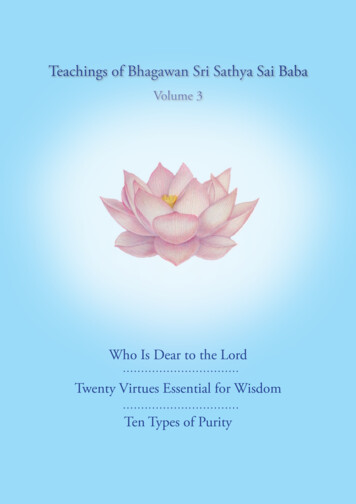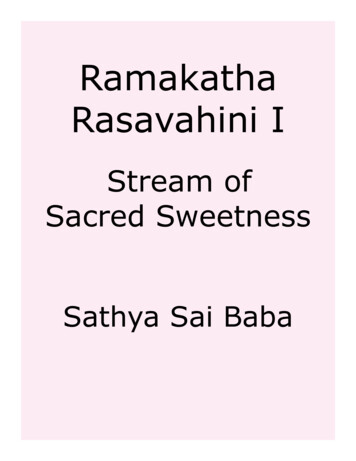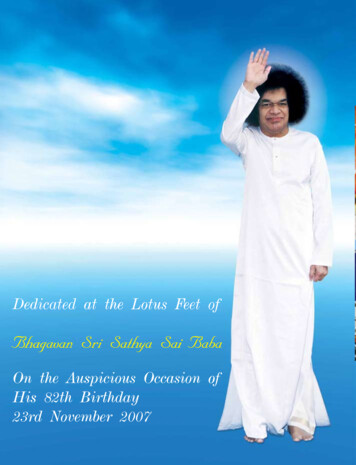
Transcription
Upanishad VahiniStream ofThe UpanishadsSATHYA SAI BABA
ContentsUpanishad Vahini 7DEAR READER! 8Preface for this Edition 9Chapter I. The Upanishads 10Study the Upanishads for higher spiritual wisdom 10Develop purity of consciousness, moral awareness, and spiritual discrimination 11Upanishads are the whisperings of God 11God is the prophet of the universal spirituality of the Upanishads 13Chapter II. Isavasya Upanishad 14The spread of the Vedic wisdom 14Renunciation is the pathway to liberation 14Work without the desire for its fruits 15See the Supreme Self in all beings and all beings in the Self 15Renunciation leads to self-realization 16To escape the cycle of birth-death, contemplate on Cosmic Divinity 16Chapter III. Katha Upanishad 17Nachiketas seeks everlasting Self-knowledge 17Yama teaches Nachiketas the Atmic wisdom 18The highest truth can be realised by all 18The Atma is beyond the senses 18Cut the tree of worldly illusion 19The secret: learn and practise the singular Omkara 20Chapter IV. Mundaka Upanishad 21The transcendent and immanent aspects of Supreme Reality 21Brahman is both the material and the instrumental cause of the world 21Perform individual duties as well as public service activities 22Om is the arrow and Brahman the target 22Brahman is beyond rituals or asceticism 23Chapter V. Mandukya Upanishad 24The waking, dream, and sleep states are appearances imposed on the Atma 24Transcend the mind and senses: Thuriya 24AUM is the symbol of the Supreme Atmic Principle 24Brahman is the cause of all causes, never an effect 25Non-dualism is the Highest Truth 25
Attain the no-mind state with non-attachment and discrimination 26Transcend all agitations and attachments 26Cause-effect nexus is delusory ignorance 26Transcend pulsating consciousness, which is the cause of creation 27Chapter VI. Brihadaranyaka Upanishad 28Atmic principles, experience, and constant practise 28The four knowledge instruments: word, seed, measure, and geometry 28Unity in diversity in nature 28Janaka’s sacrifice 29Yajnavalkya explains the significance of ritual 29Yajnavalkya explains the concept of Atma as super consciousness 29Atma is to be attained by total renunciation 30Brahman is the warp and woof of Creation 30The never-changing Reality is the basis of the phenomenal world 30Brahman is the Source of all Bliss 31All things are loved for Atma alone 31Yajnavalkya, the crown jewel of scholars of Brahmic knowledge 32Chapter VII. Prasna Upanishad 33Seekers meet the guru with sincere heart offerings 33Beings are born to perpetuate Creation 33Contemplate on the orderly universe and its principles 33Consecrate the body, a complex of vital elements, by sacrifice 34The Sun governs the vital air and vital functions 34The Self abides in all beings 35God resides in the heart 35The never-changing Absolute Reality and the ever-changing phenomenon 35Chapter VIII. Kena Upanishad 37Seek to know the Eternal, not the ephemeral 37The Atma activates and illumines all 37No knower can know the Knower of All: Atma is beyond senses 38Those who claim to know Atma don’t really know 38All people are entitled to knowledge of God; experience is the approach, the proof the result 38Snap the strings of worldly attachment 39Chapter IX. Chandogya Upanishad 40Work, worship, and wisdom 40Being or “is-ness” is the universal quality of all objects 40By knowing Atma, you will know all 40
The body decays and dies, but not the Self 41Discover omnipresent Brahman in the heart lotus! 41The journey of the soul after death 42Expand your consciousness for liberation 42To experience Reality, give up identification of the Self with the body 43Chapter X. Aithareya Upanishad 44Freedom from delusion results in vision of Atma 44Atma is unlimited, endless, changeless, all 44Atma existed before Creation 44Atma is devoid of all distinctions and beyond the reach of senses 45Atma governs the “deities” of the senses 45Lord illumines everything through living beings 45Human beings have three forms of birth 46Chapter XI. Taithiriya Upanishad 47The objective world is caused by ignorance, with bondage the result 47Liberation cannot be produced by any action 47Brahman is Truth, Omniscience, Eternal 48Do not swerve from Truth, duty, well-being of all 48The science of spirituality is the highest field of experiential knowledge 48Contemplate on the five sheaths of the human 49Rise from the gross to the subtle stage by contemplating on the vital breath 49Mantras illumine the Atmic splendour 50Chapter XII. Brahmanubhava Upanishad 51Nonduality is the essence of all Upanishads 51Brahman is described by five attributes 51Give up desire, attachment, and ego 51Atma is ever full, ever pure, and Self-luminous 52Give up desires, attachments and negate the mind 52Attain Brahman by the process of negation of senses 53God is encased everywhere 53Discover Divinity through the eye of wisdom or of love 54Joy and grief, vice and virtue are binding products of the mind 54Overcome the triple distinctions or illusions 55Glossary 56
Upanishad VahiniStream of the UpanishadsSRI SATHYA SAI SADHANA TRUSTPublications DivisionPrasanthi Nilayam - 515134Anantapur District, Andhra Pradesh, IndiaSTD: 08555 : ISD : 91-8555 Phone: 287375, Fax: 287236Email: enquiry@sssbpt.org URL www.sssbpt.org Sri Sathya Sai Sadhana Trust, Publications Division, Prasanthi Nilayam P.O. 515 134, Anantapur District, A.P.(India.)All Rights Reserved.The copyright and the rights of translation in any language are reserved by the Publishers. No part, passage, textor photograph or Artwork of this book should be reproduced, transmitted or utilised, in original language or bytranslation, in any form or by any means, electronic, mechanical, photo copying, recording or by any information,storage and retrieval system except with the express and prior permission, in writing from the Convener, Sri SathyaSai Sadhana Trust, Publications Division, Prasanthi Nilayam (Andhra Pradesh) India - Pin Code 515 134, exceptfor brief passages quoted in book review. This book can be exported from India only by the Publishers - Sri SathyaSai Sadhana Trust, Publications Division, Prasanthi Nilayam, India.International Standard Book Number:Revised Edition (ebook form): March 2014Published by:The Convener,Sri Sathya Sai Sadhana Trust,Publications DivisionPrasanthi Nilayam, Pincode 515 134, IndiaSTD: 08555 ISD: 91-8555 Phone: 287375 Fax: 287236
DEAR READER!Bhagawan Sri Sathya Sai Baba has come among humanity and is providing spiritual sustenance and guidance,in order to re-establish truth, justice, peace, and love as the mainspring of individual, social, and nationallife. He is using ancient and modern instruments for this great task, Sanathana Dharma and science. His writings,discourses, and conversations, which correct, communicate, and convince, are full of statements and commentaries on the discoveries of physical and metaphysical sciences.This book, which gives in English His articles (first published in Telugu in the Sanathana Sarathi) on theTen Upanishads (invaluable textbooks on spiritual discipline and on the glorious fruit of spiritual adventure) willreveal to you the vast limitless mercy that impels Him to save us from trivialities and prompts Him to guide usalong, until we reach the Goal of Life.Making us tread the path discovered by the sages of the past, inducing us to revere their light and theirmessage, illumining in us the flame of knowledge, which dispels delusion —that is what Bhagawan, with HisSupreme Love, does for us in this book.Let us read it with care, recapitulate it with earnestness in the silence of our hearts, and practise it with humility and faith in every turn of thought, in every tilt of tongue, and in every digit of deed.N. KASTURI Prasanthi Nilayam, 21 April 1968
Preface for this Ebook EditionThe first English edition of the Upanishad Vahini was translated by N. Kasturi from the Telugu version of thesame written by Bhagavan Sri Sathya Sai Baba and published serially in the Telugu Sanathana Sarathi. ThisEnglish edition improves on the previous one in several ways. Grammatical errors and typos have been corrected,and some sentences have been rewritten to smooth and clarify the presentation —of course, without disturbingthe original meaning. Some long paragraphs have been split in two or more paragraphs where it made sense andprovided easier reading. Numbered subtitles or sections make it easier to find one’s way in the book.Sanskrit words have been replaced by their English equivalents, to make the Upanishad Vahini more accessible to readers who do not know Sanskrit. However, where appropriate, the Sanskrit has been retained (in parentheses, following the English). Many Sanskrit words have no exact English equivalent, and retaining the Sanskritkeeps the edition accurate.Some Sanskrit compounds have been hyphenated between their constituent words to aid those who like toanalyze the meanings of the individual words. Several Sanskrit words have made their way into the English language and can be found in most dictionaries —e.g. dharma, guru, yoga, and moksha. These words have generallybeen used without translation, although their meanings appear in the glossary at the end of the book.Besides definitions of Sanskrit words used in the Upanishad Vahini, the glossary contains descriptions of thepeople and places mentioned.Finally, this ebook edition allows you, the reader, to choose the point size and font that suits you. Make useof that feature! Also, this ebook has links to the glossary. Click on most Sanskrit words, people, and places andyou will be taken to the page in the glossary where that word, person, or place is defined. Your reading applicationshould have a “back” button that will allow you to return to where you were reading.ConvenorSri Sathya Sai Sadhana Trust, Publications DivisionPrasanthi Nilayam Pin 515134, India
Chapter I. The UpanishadsHumanity is essentially divine. However, one believes oneself to be an individual, limited and temporary, because one is entangled in the characteristics of the five elements: sound, touch, form, taste, and smell. Thiserror brings about joy and grief, good and bad, birth and death. To escape from this association with the elements,to rid oneself of the pulls of their characteristics, is the sign of liberation, known as kaivalya, moksha, or mukthi.The names may change, but the achievement is the same.While entangled in the five elements, one is attracted, distracted, or disappointed by them, all of which causesdistress. Wealth, possessions —vehicles, buildings, etc.— are all transmutations of the elements. One cravesthem, and when one loses them or fails to get them, one spurns them.Let us take the five elements, one by one. The living being has the first one, the earth, as its base. Water, thesecond, is the basis for the earth. Water is produced from fire, the third element, and fire itself emanates from wind(vayu), which is the fourth. Wind arises from ether (akasa). Ether emerges from the primal nature, and the primalnature is but the manifestation of one aspect of the majesty of God, or the supreme sovereign Atma (Paramatma).Seeking to reach that supreme Atma, the source and core of the universe, the individual (jivi), who has entangled himself in the elements, has to overcome the bonds one by one, by discrimination and steady practice ofdetachment. One who does this is a spiritual aspirant, and one who wins in this struggle is liberated even whilealive (is a jivan-muktha).Study the Upanishads for higher spiritual wisdomFor the process of such discrimination and for the visualisation of one’s innate reality, one has to study theUpanishads. Collectively called Vedanta, they form the section of the Vedas that deals with the higher wisdom—the Jnana-kanda. Liberation from the consequences of ignorance can be secured only by spiritual knowledge(jnana). The Upanishads themselves declare,By knowledge alone can freedom be won(Jnaanaath eva thu kaivalyam).The Vedas are reputed to be “three-sectioned”, the three sections being spiritual wisdom (jnana), contemplation or worship (upasana), and dedicated activity (karma). These three are also found in the Upanishads; theyprovide the basis for the non-dualist (a-dwaitha), qualified non-dualist (visishta-adwaitha), and dualist (dwaitha)systems of philosophy.The word Upanishad denotes the study and practice of the innate truth, Brahma-vidya denotes the supremacyof spiritual contemplation, and Yoga-sastra denotes the mental churning that brings success.What is the fundamental activity that is required? What is the basic thing to be known? It is just one’s realreality. The Upanishads describe the various stages and modes of this search.The name Upanishad is full of significance. Upa-ni means the process of studying with steadfastness (nishta); shath means the attainment of the Ultimate Reality. The name Upa-ni-shath arose for these reasons. The Upanishads do not only teach the principles of knowledge of the supreme Reality (Atma-vidya), they also instruct in
the practical means of realisation. They point out not only the duties and obligations one has to bear but also tellus the acts to be done and those to be avoided.Why, the Gita is but the essence of the Upanishads, isn’t it? Arjuna acquired by the lessons of the Gita thefruit of listening to the Upanishads. The statement, “That thou art (Thath twam asi)” is found in the Upanishads.In the Gita, Krishna says to Arjuna, “I am Arjuna among the Pandavas,” that is to say, “I and You are the same.”This is the same as saying “Thou art That,” that the individual and God (jiva and Iswara) are the same. So, whetherit is the Gita or the Upanishads, the teaching is non-duality, not duality or qualified monism.Develop purity of consciousness, moral awareness, and spiritual discriminationThe human eye cannot delve into the microcosm or the macrocosm. It cannot read the mystery of the virus orthe atom or the stellar universe. Therefore, scientists supplement the eye with the microscope and the telescope.Similarly, sages are able to experience Divinity through the eye of knowledge gained by following the dharma ofmoral conduct and spiritual discipline.When the human eye needs an extraneous instrument to observe even the insignificant worm and virus, howcan a person refuse to go through the process of mantra in order to see the omnipresent transcendent Principle? Itis very hard to acquire the eye of wisdom. Concentration is essential for it. And, for concentration to develop andstabilise, three things are very important: purity of consciousness, moral awareness, and spiritual discrimination.These qualifications are difficult for ordinary folk to attain.But humanity is endowed with the special instrument of discrimination, of judgement, of analysis and synthesis. Among the animals, only mankind possesses it. It has to be developed and utilised to the best purpose.Through this instrument, one can realise the immanent Divinity.Instead, one pesters oneself and others with questions like: Where does God reside? If He is real, why isn’tHe seen? Hearing such queries, one feels like pitying the poor questioners, for they are announcing their ownfoolishness. They are like the dullards who aspire for university degrees without taking pains even to learn thealphabet. They aspire to realise God without putting themselves to the trouble of the required spiritual discipline.People who have no moral strength and purity talk of God and His existence and decry efforts to see Him —suchpeople have no right to be heard.Upanishads are the whisperings of GodSpiritual practice is based on the holy scriptures (sastras). They can’t be mastered in a trice. They can’t befollowed through talk. Their message is summed up in the Upanishads, so they are revered as authoritative. Theyare not the products of human intelligence; they are the whisperings of God to man. They are parts of the eternalVedas, and the Vedas shine gloriously through all their parts.The Upanishads are authentic and authoritative, since they share the glory of the Vedas. They are 1180 innumber, but, through the centuries, many of them disappeared from human memory and only 108 have survived.Of the 108, 10 have attained great popularity as a result of the depth and value of their contents.The sage Vyasa classified the Upanishads and allotted them among the four Vedas. The Rig-veda has 21branches, and each branch has one Upanishad allotted to it. The Yajur-veda has 109 branches and 109 Upani-
shads. The Atharvana-veda has 50 branches and 50 Upanishads. The Sama-veda has 1000 and 1000. Thus, Vyasaassigned the 1180 Upanishads to the four Vedas.Sankaracharya raised the status of ten of the Upanishads by selecting them for writing his commentaries, sothey became specially important. Humanity stands to gain or fall by these ten. All who seek human welfare andprogress are now apprehending whether even these ten will be forgotten, because neglecting them will usher inmoral and spiritual disaster. However, there is no reason for such fears. The Vedas can never be harmed. Punditsand those with faith should resolve to present at least these ten Upanishads before humanity. They are:01. Aithareya04. Isa07. Prasna03. Chandogya06. Katha09. Mandukya02. Brihadaranyaka05. Kena08. Mundaka10. TaithiriyaThe remaining 98 are:11. Adhyatma36. Ganapathi61. Muktika86. Sathyayana13. Aksha-malika38. Garuda63. Narada-parivrajaka88. Sita12. Adhvayatharaka14. Akshik15. Amritha-bindu16. Amrithanada17. Annapurna18. Aruni19. Atharvasikha20. Atharvasira21. Atma22. Atmabodha23. Avadhutha24. Avyaktha25. Bhasma26. Bhavana27. Bhavaricha28. Brahmajabala29. Brahmana30. Brahma-vidya31. Dakshinamurthi32. Dattatreya33. Devi34. Dhyana-bindu35. Ekakshara37. Garbha39. Gopalatapani40. Hamsa41. Hayagriva42. Jabaladarshana43. Jabali44. Kaivalya45. Kalaagnirudra46. Katharudra47. Katharudra48. Kaushitaka49. Krishna50. Kshithi51. Kshurika52. Kundiska53. Maha-bhiksuka54. Mahanarayana55. Mahavakya56. Maitrayani57. Maitreyi58. Mandala59. Mantrika60. Mudgala62. Nadabindu64. Narasimha65. Narayana66. Niralamba67. Nirvana68. Nrisimhatapani69. Paingala70. Panchabrahma71. Parabrahma72. Paramahamsa73. Parama-parivrajaka74. Pasupatha75. Pranagnihotra76. Ramarahasya77. Ramathapani78. Rudrahridaya79. Rudraksha80. Sandilya81. Sanyasa82. Sarabha83. Saraswathi-rahasya84. Sariraka87. Savithri89. Skanda90. Soubhagyalakshmi91. Sukarahasya92. Sulabha93. Surya94. Swethasvatara95. Tejobindu96. Tharasara97. Thripura98. Thripurathapini99. Thuriyatita100. Trisikhi-brahmana101. Vajrasuchika102. Varaha103. Vasudeva104. Yajnavalkya105. Yogachudamani106. Yogakundalini107. Yogasikha108. Yogathathwa85. Sarva-sarThe Upanishads have inspired other works on geography, astronomy, astrology, and economic and politicaltheory, as well as the eighteen Puranas comprising Skanda, Siva, Garuda, and others.God is the prophet of the universal spirituality of the UpanishadsThe Vedas and the Upanishads are the very foundation of the Eternal Religion (Sanathana Dharma). This
religion has no one founder, as do others. The invisible unknown founder is God, the source of all wisdom. He isthe prophet of this eternal universal religion. His grace and inspiration manifested through pure sages, and theybecame the spokespersons of this dharma. When the moral purity of men degenerates, God takes form as graceand inspiration in sages and teachers. Through the Upanishads, He has also spoken the wisdom concerning theSupreme Reality.
Chapter II. Isavasya UpanishadThe spread of the Vedic wisdomThe Lord, intent on the regeneration of the world, communicated Vedas through Hiranyagarbha, who in turnpassed them on to His ten mental sons (manasa-putras), including Athri and Marichi. From them, the Vedasspread among humanity, handed down from one generation to another. As time passed and ages accumulated andcontinents moved, some Vedas got lost or were neglected as too difficult for comprehension, and only four havesurvived into modern times. These four were taught in the Dwapara era (yuga) to his disciples by Veda Vyasa, thegreatest of the exponents of the Vedas.When Vyasa was thus expounding the Vedas, engaged in spreading the sacred scripture, one disciple of his,Yajnavalkya by name, incurred his wrath. As punishment, Yajnavalkya had to regurgitate the Yajur-veda, whichhe had already learned, into the custody of his guru, leave the place, and take refuge in the divine Sun (Surya-deva), the treasure-house of the Vedas. Just then, the sages, who revere the Vedas, flew into the place in the shape ofpartridges (thithiri) and ate up the regurgitated Yajur-veda. That particular section of the Veda is called Taithirya.Meanwhile, the Sun was pleased with the devotion and steadfastness of the unfortunate Yajnavalkya. He assumed the form of a horse (vaji) and blessed the sage with renewed knowledge of the Yajur-veda. The version thustaught by the horse came to be called Vajasaneyi. The Yajur-veda as promoted by Veda Vyasa is called KrishnaYajur Veda; that handed down by Yajnavalkya, Sukla Yajur Veda. (Krishna means black; sukla, white).The first few sections, the Karma-kandas of these Vedas are mantras connected with ritual actions, and thelast few sections, the Jnana-kandas, deal with spiritual wisdom.Renunciation is the pathway to liberationThe Isavasya Upanishad is concerned with the sections on spiritual wisdom (Jnana-kanda). Since the opening mantra of this Upanishad starts with the word Isavasya (pervaded by the Supreme), the Upanishad is calledby that name.All things of this world —the transitory, the evanescent— are enveloped by theLord, who is the true Reality of each. Therefore, they have to be used with reverentrenunciation and without covetousness or greed, for they belong to the Lord and notto any one person.Ishaavaasyam idham sarvam yathkinchatjagath-yaam jagath. Thena thyakthena bhunjeethaa,maa gridhah kasya svith dhanam.This verse says that the universe is the immanence of the Lord, His form, His body. It is wrong to take theuniverse and Its Lord as different. It is a delusion, just a product of your own imagination. Just as your imageunder the water is not different from you, the universe (which is His image produced on your ignorance) is thesame as He.As long as one has this delusion, one cannot visualise the Reality immanent within; in fact, one will slide
into wrong thoughts, words, and deeds. A piece of sandalwood produces a bad smell when kept in water, but whentaken out and rubbed into paste, the former perfume will return. When the authority of the Vedas and scripturesis respected, and when discrimination is sharpened on the practice of dharmic actions, the evil smell of wrongand wickedness will vanish and the pure innate perfume of the Atma will emerge. Then, the duality of doer andenjoyer will disappear, and the stage will be reached that is called withdrawal from all activity (sarva-karmasanyas). In this Upanishad, this type of renunciation (sanyasa) is described as the pathway to liberation.Work without the desire for its fruitsRenunciation that involves the destruction of the three urges for a mate, for progeny, and for wealth is verydifficult to attain without purity of the mind (chittha).In this Upanishad, the means for obtaining this renunciation is declared in the second mantra: carry out thedaily offering of milk to the god of fire, etc. prescribed in the scriptures, believe that for liberation one has to beactively engaged in such work, and become convinced that no sin can cling as long as one is so engaged. Workwithout the desire for its fruit slowly cleanses impurities, like the crucible of the gold-smith. The pure mind isspiritual wisdom (jnana); it is the consummation of detachment.If you are able to divest yourselves of desire when you are doing work, no impurity can touch you. You knowthat “chilliginji” seeds, when dropped into muddy water, have the power to separate the dirt and deposit it at thebottom; the seeds also sink to the bottom and slip out of sight! In the same way, those who are adepts in doingaction (karma) without attachment have their minds perfectly cleansed, and the results of their acts lose their effectiveness and sink to the bottom.Out of the 18 mantras in this Upanishad, only the first two deal directly with the problem of liberation andits solution. The other sixteen elaborate on this solution and serve as commentaries thereon.See the Supreme Self in all beings and all beings in the SelfThe Atma never undergoes modification; yet, it is faster than the mind! That is the mystery and the miracle.It appears to experience all states, but it has no growth, decline, or change. Though it is everywhere, it is notperceivable by the senses. It is because of its underlying existence and ever-present immanence that all growth,all activities, all changes take place. Cause and effect act and react on account of the basic stratum of the Atmicreality. Why, the very word “Lord (Isa)” carries this meaning. The Atma is near and far, inside and outside, stilland moving. He who knows this truth is worthy of the name “spiritually wise person (jnani)”.The ignorant can never grasp the fact of Atmic immanence. Those who are conscious can see things and feeltheir presence. Those who have lost awareness will search for the lost jewels, even though they actually wearthem at the moment. Though one may know all things, one conceives the Atma as existing in some unapproachable, unreachable place on account of loss of consciousness. But the wise person, who is aware, sees the Atma inall beings and sees all beings as Atma. The wise person sees all beings as the same and perceives no distinction ordifference. So the wise person saves themself from duality.The Isavasya Upanishad makes this great truth clear to all. Wise people, who have tasted that vision, willnot be agitated by the blows of fortune or the enticements of the senses. They see all beings as themselves, having
their own innate identity; they are free from bondage, from dharma and lack of dharma (a-dharma), and from theneeds and urges of the body. They are “self-illuminating (swayam-prakasa)”. So, the individual body (jiva-rupa)is not their genuine form, no, not even the gross and the subtle bodies are their forms.That is why the first mantra of the Isavasya expounds on intentness on acquiring spiritual wisdom (jnananishta) characterised by the absence of craving of any sort. This is the primary goal of the Vedas. But those whohave cravings will find it difficult to get stabilised in that state of mind (nishta). For such, the second mantraprescribes a secondary means, ritual action (karma-nishta).The rest of the mantras elaborate and support these two states —based on spiritual wisdom and action. Ritualaction has desire and delusion as the cardinal urges; intentness on the cultivation of spiritual wisdom has discrimination (vairagya), the conviction that the world is not Atma, that is to say, not true, so it is profitless to have anydealings with it. Such an attitude of discrimination is the gateway to acquiring spiritual wisdom.From the third to the eighth mantra, the real nature of the Atma is depicted through the condemnation ofignorance (a-vidya), which prevents understanding Atma.Renunciation leads to self-realizationThus the Isavasya teaches the lesson of renunciation through the first mantra and the lesson of “liberatingactivity” (through action devoid of attachment and anger (raga and dwesha)) in the second mantra. In the fourthand fifth mantras, it speaks of the Atmic principle (Atma-thathwa) and later of the fruits of the knowledge of thatAtmic principle.In the ninth mantra, the path of progressive liberation (karma-mukthi) is laid down. This path is useful forthose who are too weak to follow the path of total renunciation but who are adepts in acts that are conduciveto moral development and inner purification. This path coordinates all action on the principle of contemplativeworship. Those who are engaged in acts that are contrary to spiritual knowledge (vidya) are full of ignorance, itsays; those who confine themselves to the study and practice of divine forms are even worse, for their desire is forpowers and skills. Knowledge leads to the world of the gods (deva loka), while action leads to the world of thefathers (pitru loka), it is said. So the spiritual wisdom (jnana) that results in Self-realization (Atma-sakshathkara)is something quite distinct from these; no attempt to coordinate the two can succeed.To escape the cycle of birth-death, contemplate on Cosmic DivinityOf course, one should not engage in anything opposed to the scriptures, and in the ultimate analysis, all actions are classed as ignorance (a-vidya). At best, action (karma) can help only to cleanse the mind, and contemplative worship can help only to achieve single-mindedness. Worship has to rise to the level of contemplation of thecosmic Divinity, the Hiranyagarbha; it has to ripen and develop into liberation while alive (jivan-mukthi) beforethe end of this life.Knowledge of gods (devatha-jnana) and ritual actions have to be complementary and coordinated; then, onecan escape the round of birth and death and become divine.
Chapter III. Katha UpanishadThis Upanishad contains the story of Nachiketas, who was initiated into spiritual discipline by Yama himself.The same story is also mentioned in the Taithiriya Upanishad and its Brahmana portion and also in the Mahabharatha, in chapter 106 of the section of moral principles. This Upanishad has become famous on accountof its clarity and depth of imagination. Many of the thoughts expressed in it can be found in the Bhagavad Gita.Sinc
Study the Upanishads for higher spiritual wisdom For the process of such discrimination and for the visualisation of one's innate reality, one has to study the Upanishads. Collectively called Vedanta, they form the section of the Vedas that deals with the higher wisdom —the Jnana-kanda (). The (). The ) Upanishad Upanishad);
